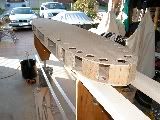Wow! Thanks so much for the feedback (both here and in the many emails I’ve gotten). This is EXACTLY what I was hoping for - suggestions BEFORE we begin filming from folks who would eventually be the viewers . This will surely make the DVD most useful. Please - keep’m coming!
To clarify up front, this is NOT the Jensen method. Those interested in that approach should buy his CD “How to build a hollow surfboard” I hear great things about it.
In response to some of your emails:
A (very) little background:
Mike (the other builder at GSB) and I live in Maine. For many years we talked about shaping out own boards. When the talk turned toward using wood, we immediatley drew on our boat experiences, and in particular New England boat-building techniques to try building our own. To make a long story short, we found some time tested techniques used to build lobster boats to work extremely well, and some not so well. So we’ve modified our ways (a classic example of boat-building evolution) to make the process most efficient for our smaller “watercraft.”
There are fundamental differences in the GSB approach. It’s all about the WOOD. We really like the idea of tradition and are commited to using the absolute minimum of glass and epoxy. In fact, we’re really trying to develp a glass-free, and maybe even an epoxy-free method too (the very first board we made, called Eve, was both glass and epoxy free, albeit heavy). We depend on the wood for strength and exploit it’s natural bending qualities to “fair out” our curves (a sometimes tricky thing to do with 1/4" frame members).
Simplicity is also a key factor for us. We want people to succeed in building thier own board, not get bogged down building gluing forms or having to buy expensive tools (maybe it’s a Maine thing). When you build a GSB board, all the work is done on-the-board - just like a boat. The keel is laid first, frames go on keel, planks on frames, rails on planks. No bending is done “off” the board. in effect the board IS the gluing form. Don’t get me wrong, it’s still challenging for woodworking newbies, and you will need a few key tools, but you won’t have to be Norm Abrams, or an off-duty cabinet maker to do it.
On a green note, environmental concerns are a high priority (in fact my personal highest). We’re developing relationships with sustainable wood producers (such as Vermont Family Forests) And strongly encourage (more like require) builders to commit to planting at least ten trees for every board they build. I suggest planting some of them in places that really need them - like the “islands” in the middle of Wal-Mart parking lots. Sorry about this little tree-hugger digresion.
While I’m at, let me just mention my view of this community. There are people out there with lots of money, but not a lot of time, or desire to build thier own board. But they still want to have a beautiful, functional, and unique board. We serve those types by building pricey boards for them. I venture to guess, not many of those types are reading this right now. But then there is you - the Swaylockeans who we see more as our peers. We’re willing to share ideas with you (in both directions) simply because we share your stoke.
And yes Rhino they are hollow…built hollow, not chambered.
PS…A pack of cedar seeds will come with each kit.



